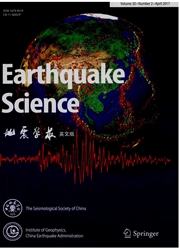

 中文摘要:
中文摘要:
瑞利面波垂直-水平振幅比(或ZH振幅比)是一个随频率变化的函数,对于台站下方浅层地壳结构非常敏感,且具有和频散资料不同的深度敏感核,是传统频散反演方法的一个很好的补充,从而可以将基阶瑞利面波的ZH振幅比和面波频散数据联合起来更好地反演获得观测台站下方的速度结构.本文提出了基于邻域算法的面波频散曲线与ZH振幅比联合反演方法,我们进行了基于理论模型的模拟测试,证明了联合反演是一种更为可靠的反演方法,且能更好地约束浅层地壳结构.相比于频散曲线单独反演,联合反演不仅可以精确反演获得地壳的Vs结构,对分层地壳的Vp/Vs也能很好地约束.然后我们将联合反演算法应用于实际测量数据,获得了中国西南昆明台(KMI)下方更为准确的地壳横波速度结构及Vp/Vs模型.
 英文摘要:
英文摘要:
Rayleigh wave ellipticity(or ZH ratio)is a function of frequency and is particularly sensitive to shallow crustal structure beneath the seismograph station.Since depth sensitivity kernels of ZH ratios are different from those of dispersion data,the ZH ratio provides good complementary information for the dispersion-based inversion method.Therefore,we can combine the ZH ratio and dispersion data of Rayleigh wave fundamental mode to better invert for the velocity structure under a specific seismograph station.In this paper,we propose a joint inversion method using the dispersion and ZH ratio data based on the Neighborhood Algorithm.Weconduct synthetic tests based on a theoretical model and prove the robustness of the joint inversion method,which can better constrain the shallow crustal structure.Compared to traditional inversion methods that only use dispersion data,the joint inversion can provide a more accurate crustal Vsmodel as well as Vp/Vsratios for the layered crust.Finally,we apply the joint inversion technique to real measurements and obtain a more accurate crust shear velocity and Vp/Vs model beneath the station at Kunming(KMI)in southwest China.
 同期刊论文项目
同期刊论文项目
 同项目期刊论文
同项目期刊论文
 Compressive sensing of frequency-dependent seismic radiation from subduction zone megathrust rupture
Compressive sensing of frequency-dependent seismic radiation from subduction zone megathrust rupture Direct inversion of surface wave dispersion for three-dimensional shallow crustal structure based on
Direct inversion of surface wave dispersion for three-dimensional shallow crustal structure based on Crustal and upper mantle S-wave velocity structures across the Taiwan Strait from ambient seismic no
Crustal and upper mantle S-wave velocity structures across the Taiwan Strait from ambient seismic no 期刊信息
期刊信息
